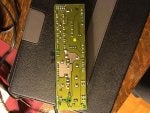I've been looking into an issue with my father-in-law's 2000 E320 that started this Sunday, June 11. We had driven the car without any issues in the morning and early afternoon, but in the late afternoon after making a stop and removing the key from the ignition, we were unable to get it started back up. There weren't any signs that something was about to go wrong as far as I know. If it's relevant, the atmospheric conditions were a temperature of 83F and humidity of 44%.
We are able to unlock the car normally with the key fob. When we put the fob into the ignition and turn it to the on position, all cabin electronics come on and operate normally. When we turn the key to the ignition position, however, we can't hear any of the normal responses we'd expect from the engine - starter motor or engine crank. However, from inside the engine compartment, we can hear a few brief clicking sounds.
We've tested the battery - it shows 12.6 volts when the car is inactive, and 12.3 volts when the ignition is in the on position with electronics running. There is no voltage change at the battery when we turn the key to ignition.
One of the suggestions I found in this forum to fix this and a variety of other issues with W210 cars was to remove the K40, redo the solder points on the PCB, and replace. I want to try this repair as a first step, since it doesn't cost anything.
I found what appeared to be the right compartment in the engine - it was on the right hand (passenger) side of the car, marked with an air conditioner label. It was covered by a plastic top with four captive phillips screws. Inside the compartment were three computer-ish looking devices, plus what appeared to be a fuse box with lots of cables coming out. However, when I had disconnected the cables and removed the box, the relay looked significantly different than the ones I had seen on various YouTube videos and photos I found online.
This is what I was expecting: external link to large image
But what I found looked quite different:
From the top:
![]()
From the bottom:
![]()
There were also far more cables attached to the top than I was expecting. Not sure if I removed the wrong part, or if it's just a different version on this particular model. I've also seen some other people mention that there are *two* K40's, and the other is on the other side of the engine compartment. But I don't see anything that fits that description over there, just the main fuse box (unless it's hidden under the back of the fuse box).
Any idea if what I'm looking at is the right part, or if I should be looking elsewhere? I just want to make sure it's right before I go resoldering anything.
Thanks!
We are able to unlock the car normally with the key fob. When we put the fob into the ignition and turn it to the on position, all cabin electronics come on and operate normally. When we turn the key to the ignition position, however, we can't hear any of the normal responses we'd expect from the engine - starter motor or engine crank. However, from inside the engine compartment, we can hear a few brief clicking sounds.
We've tested the battery - it shows 12.6 volts when the car is inactive, and 12.3 volts when the ignition is in the on position with electronics running. There is no voltage change at the battery when we turn the key to ignition.
One of the suggestions I found in this forum to fix this and a variety of other issues with W210 cars was to remove the K40, redo the solder points on the PCB, and replace. I want to try this repair as a first step, since it doesn't cost anything.
I found what appeared to be the right compartment in the engine - it was on the right hand (passenger) side of the car, marked with an air conditioner label. It was covered by a plastic top with four captive phillips screws. Inside the compartment were three computer-ish looking devices, plus what appeared to be a fuse box with lots of cables coming out. However, when I had disconnected the cables and removed the box, the relay looked significantly different than the ones I had seen on various YouTube videos and photos I found online.
This is what I was expecting: external link to large image
But what I found looked quite different:
From the top:

From the bottom:

There were also far more cables attached to the top than I was expecting. Not sure if I removed the wrong part, or if it's just a different version on this particular model. I've also seen some other people mention that there are *two* K40's, and the other is on the other side of the engine compartment. But I don't see anything that fits that description over there, just the main fuse box (unless it's hidden under the back of the fuse box).
Any idea if what I'm looking at is the right part, or if I should be looking elsewhere? I just want to make sure it's right before I go resoldering anything.
Thanks!




